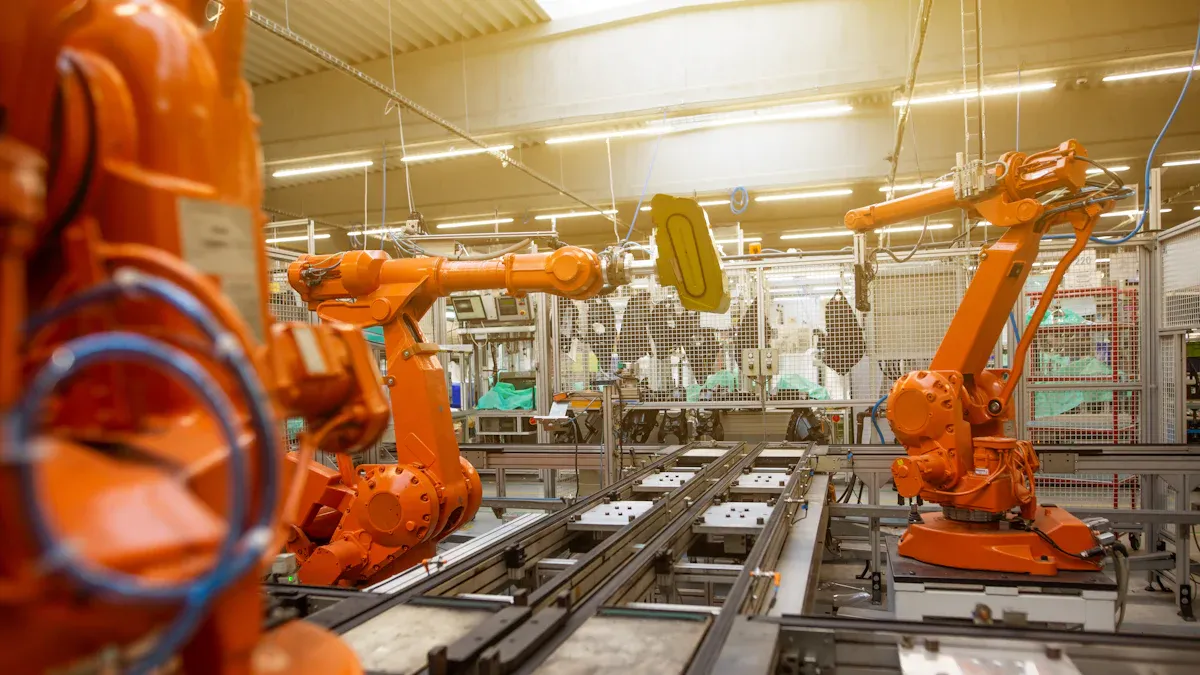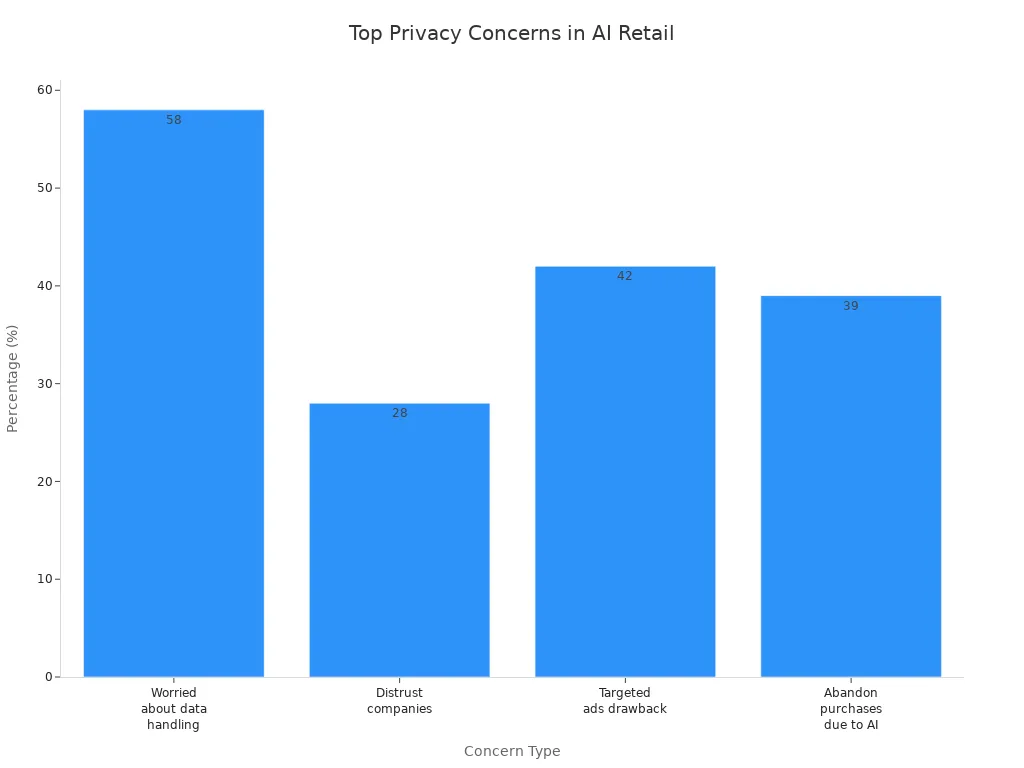AI Stores vs Traditional Retail: How Automation Is Redefining Store Operations

Artificial intelligence and automation now shape how you experience retail. Many stores use artificial intelligence to personalize shopping, manage inventory, and speed up checkout. In 2024, 86% of retail companies have adopted AI or automation, and 72% plan to deploy generative AI.
Statistic | Value | Source |
|---|---|---|
Retailers ready to deploy generative AI in 2024 | 72% | Google's retail research |
Retail companies implementing AI or automation | 86% | McKinsey's retail analysis |
Retailers struggling to achieve AI value | 74% | BCG and MIT |
Retailers using or assessing AI projects | 89% | N/A |
Retail AI market projected size by 2033 | $127.2 billion | Market research projections |
When you compare AI Stores vs Traditional Retail, you see clear differences. AI stores offer personalized shopping and fast, automated checkouts, while traditional stores depend on manual processes and longer wait times. You may wonder how these changes affect daily operations, customer satisfaction, and business success.
Key Takeaways
AI stores offer personalized shopping experiences, using data to suggest products that match your preferences, leading to higher customer satisfaction.
Automation speeds up the checkout process in AI stores, allowing for faster transactions and fewer errors compared to traditional retail.
Smart inventory management in AI stores ensures shelves are always stocked, reducing waste and improving efficiency through real-time tracking.
Retailers using AI and automation can save costs and improve operational efficiency, allowing them to invest in better customer experiences.
The future of retail will see more AI integration, enhancing shopping with features like dynamic pricing, cashier-free checkouts, and personalized marketing.
Retail Transformation
Automation in Retail
You see retail transformation happening everywhere. Automation changes how you shop and how stores operate. Many retailers use AI to make decisions faster and more accurately. You notice that smart retail uses IoT, AI, and automation to create real-time solutions. For example, IoT sensors track products on shelves, and AI predicts what you want to buy next. Automation helps stores adjust prices, manage inventory, and even prevent theft. You can look at the table below to see how AI and automation impact retail:
Application | Impact |
|---|---|
Pricing Comparison | Retailers use AI to adjust pricing and product selections in response to global trade conditions. |
Product Description | Generative AI summarizes complex product descriptions, enhancing customer appeal. |
Cross-Selling | AI analyzes order history to suggest relevant additional purchases. |
Inventory Management | Robots with AI assist in stock counting and cleaning tasks. |
Theft Prevention | AI helps reduce losses from theft and fraud, addressing over $110 billion in annual losses. |
Store Location | AI simulates various factors to optimize new store placements. |
Fulfillment Centers | Amazon uses AI for trend prediction and efficient logistics. |
Supply Chain | Walmart employs AI for real-time stock tracking and waste reduction. |
Personalized Experience | Sephora uses AI for tailored customer interactions. |
Trend Prediction | H&M leverages AI for fashion forecasting and inventory management. |
Economic Impact | AI is projected to add $13 trillion to the global economy by 2030. |
Market Growth | The AI retail market is expected to grow from $9.85 billion to $40.49 billion by 2029. |
Chatbot Usage | Retail spending through chatbots is forecasted to rise from $12 billion in 2023 to $72 billion by 2028. |
You see that smart retail uses these tools to make shopping easier and more personal.
Smart Stores
Smart stores lead the way in retail transformation. You experience faster shopping with cashier-less checkouts and personalized deals through mobile apps. Smart stores use smart inventory management to keep shelves full and suggest products you might like. You notice that smart stores streamline operations for owners and staff. These stores use IoT as a digital nervous system, with smart sensors and real-time tracking. Edge computing processes data locally, so smart stores respond quickly. AI in smart stores recognizes patterns and helps you find what you need. Automation in smart stores keeps everything running smoothly, even during outages.
Smart stores stand out from traditional stores. You see unmanned, technology-driven operations and self-service options. Smart stores use facial recognition, QR codes, and advanced AI. You enjoy immersive shopping experiences and 24/7 self-service. Smart retail environments make every visit unique.
Characteristic/Technology | Smart Stores | Traditional Retail Stores |
|---|---|---|
Operation | Unmanned, technology-driven | Staffed, personnel-dependent |
Customer Interaction | Self-service, contactless | Direct interaction with staff |
Technology Utilization | Advanced technologies (facial recognition, QR codes, AI, IoT) | Basic technologies (self-service checkouts, mobile payments) |
Shopping Experience | Immersive, enhanced physical experience | Standard shopping experience |
Service Availability | 24/7 self-service | Limited to store hours |
Smart stores and autonomous stores show you the future of smart retail. You see how smart stores use automation, AI, and IoT to create a seamless experience. Smart retail keeps evolving, and you benefit from every new feature smart stores offer.
AI Stores vs Traditional Retail

Personalization
When you walk into ai stores vs traditional retail, you notice a big difference in how each store treats you. In ai stores, you get personalized shopping from the moment you enter. Smart systems track your preferences and suggest personalized product recommendations based on your past purchases and browsing habits. You see personalized deals pop up on your phone or in-store screens. These stores use ai-powered personalization to create a unique experience for every shopper.
In traditional retail, you often rely on staff for help. You might get some recommendations, but they are not always personalized. The staff may not know your preferences or shopping history. This means you get a standard shopping experience, not a personalized one.
You benefit from ai-driven personalization in many ways:
You receive personalized recommendations that match your style and needs.
You see targeted promotions that increase your chances of finding what you want.
You enjoy a smoother shopping journey with less time spent searching.
Studies show that 80% of consumers are more likely to buy from brands that offer personalized experiences. Retailers using ai-driven personalization report a 25% increase in marketing ROI and a 20% boost in sales. You also see higher customer satisfaction and loyalty, with some stores reporting a 30% jump in satisfaction scores.
Here is how some companies use personalization:
Company | Operational Difference | Results |
|---|---|---|
Amazon/Shopify | Personalized shopping assistants adapt to your behavior and preferences | 25% higher average order values, 19% lower return rates |
Sephora | In-store ai acts as a digital beauty consultant, giving personalized product recommendations | Increased customer satisfaction and loyalty |
You get more value and a better customer experience in ai stores vs traditional retail because of these personalized features.
Checkout Process
The checkout process in ai stores vs traditional retail feels very different. In ai stores, you use seamless checkout options. You scan your items, pay with your phone, or even walk out while sensors and cameras track your purchases. This makes checkout fast and easy. You spend less time waiting in line and avoid mistakes.
Traditional retail relies on cashiers and manual scanning. You often wait in long lines, and mistakes can happen when staff enter prices or scan items. This slows down your shopping and can lead to frustration.
Let’s compare the two checkout systems:
Feature | AI-Powered Checkout | Traditional Checkout |
|---|---|---|
Speed | Significantly faster transactions | Slower due to manual processes |
Error Rates | Fewer mistakes due to automation | Higher risk of human error |
Automation | Automates key steps in the process | Relies on manual input |
Adaptability | Adapts in real-time to shopper behavior | Static and less responsive |
You notice that ai image recognition technology quickly identifies products, reducing manual input and speeding up the process. AI vision checkout terminals process items faster than traditional systems, which means you spend less time at the register. Automation in ai stores vs traditional retail leads to fewer errors and a smoother experience.
Inventory Management
Inventory management is another area where ai stores vs traditional retail show clear differences. In ai stores, automation tracks stock levels in real time. Sensors and ai systems monitor shelves and trigger restocking orders automatically. You rarely see empty shelves because the system keeps everything stocked.
Traditional retail uses manual stock checks. Staff must count items and place orders by hand. This takes more time and can lead to mistakes or out-of-stock products.
Here are some benefits of ai-based inventory management:
Automation reduces time spent on stocktaking and minimizes errors.
AI-powered demand forecasting aligns inventory with actual demand, reducing waste.
Benefit | Measurement |
|---|---|
Reduction in forecasting errors | 20-50% compared to traditional methods |
Accuracy rate in inventory | 95% using AI-powered systems |
Reduction in inventory costs | 30% by using AI-powered systems |
Walmart uses autonomous inventory management with ai to monitor stock and trigger restocking. This led to a 30% reduction in out-of-stock events in just six months. H&M uses ai-driven visual merchandising to optimize store layouts, which increased basket size by 17%. These examples show how ai stores vs traditional retail differ in efficiency and results.
You see that ai stores vs traditional retail offer more accurate, efficient, and personalized shopping. Automation and ai help stores provide better personalized product recommendations, seamless checkout options, and smarter inventory management. This leads to a better experience for you and improved business outcomes for retailers.
Benefits of Automation

Efficiency
You see automation changing how stores work every day. When stores use ai-powered solutions, they complete tasks faster and with fewer mistakes. Automation helps you get what you need quickly, and it makes retail experiences smoother for everyone. Stores use retail ai platforms to track inventory, process transactions, and manage orders. These systems work around the clock, so you always find shelves stocked and lines moving fast.
Here is a table that shows how automation improves efficiency in retail:
Evidence Type | Statistic/Claim | Source |
|---|---|---|
Operational Cost Reduction | Reduction in operational costs by up to 55% through automation of repetitive tasks | McKinsey & Company |
Employee Time Optimization | Automation can free up to 65% of employees' time for value-adding tasks | McKinsey & Company |
Inventory Management Improvement | Increased space utilization by up to 85% through automated inventory systems | Convenience Retailers |
Transaction Processing Efficiency | Automated checkout systems can process up to twice as many transactions per hour | Convenience Retailers |
You notice that stores using automation process orders faster and keep products available. Retailers see fewer errors in order fulfillment, and workflows become simpler. Automation lets stores handle more orders, especially during busy seasons. You benefit from these improvements every time you shop.
Automation reduces human errors and streamlines workflows. You get more accurate orders and faster service. Retailers use ai to scale up operations and deliver better retail experiences.
Cost Savings
Automation helps stores save money in many ways. When stores use retail ai platforms, they reduce labor costs and cut down on mistakes. Automation lets teams focus on important tasks instead of repetitive work. Retailers use ai to forecast price changes and optimize inventory, which helps manage costs.
Here is a table that shows how automation leads to cost savings in retail:
Evidence Description | Source |
|---|---|
Automation enhances efficiency, reduces errors, and streamlines operations, leading to cost savings for retailers. | Softco |
Advanced data analytics and automated systems help retailers forecast price changes and optimize inventory, which contributes to managing operational costs effectively. | McKinsey & Company |
Transitioning to automated processes significantly reduces time and errors in invoice processing, resulting in cost benefits. | PWC |
AI workflow automation solutions lead to significant cost savings and improved operational efficiency. | Quixy |
Intelligent automation reduces labor costs by handling repetitive tasks, allowing teams to focus on higher-value activities. | Integranxt |
Stores using automation see big drops in labor and inventory costs. For example, one retailer reduced inventory costs by 40%, stockouts by 25%, and overstocking by 30%. Lead times dropped by 20%. These savings help stores offer better prices and invest in new retail experiences.
You also see profit margins grow when stores use automation. Retailers use ai-powered automation to handle data entry, scheduling, and customer support. Modern technologies like robotics and ai-driven automation cut labor costs and improve logistics. Retailers analyze data to forecast trends and optimize inventory, which reduces waste and boosts profits. Smart supply chain solutions and energy-saving practices also help stores keep more of their earnings.
Customer Experience
You enjoy a better customer experience when stores use automation. Retailers use ai to personalize your shopping journey and make every visit special. Automation helps stores deliver faster service and more accurate orders. You see chatbots answering questions and helping you find products. These tools make your digital shopping experience easier and more enjoyable.
Retailers use automation to improve demand forecasting. Walmart uses ai models to analyze sales data, economic trends, and local demographics. This helps stores adjust inventory and meet your needs. Machine learning makes forecasts more accurate and reduces costs. Automated systems alert planners to changes in demand, so stores can respond quickly. Real-time data from RFID and IoT technologies helps stores make fast decisions and avoid mistakes.
Automation creates retail experiences that are smooth, fast, and personal. You get the products you want, when you want them. Stores use retail ai platforms to deliver better service and keep you coming back.
You see automation in e-commerce, physical stores, and across the retail-industry. Retailers use ai to create new retail experiences and improve every part of your shopping journey. Automation helps stores grow, save money, and deliver the best customer experience possible.
Challenges for Retailers
Integration
You may notice that bringing new technology into stores is not always easy. Many retail companies face big challenges when they try to add ai and automation to their existing systems. You often see high costs for new technology, which can be hard for small and medium-sized stores. It takes a lot of time and resources to connect new systems with old ones. Sometimes, stores do not have enough skilled workers who understand ai. This shortage slows down progress.
Here is a table that shows common integration issues:
Challenge | Impact on Retail Stores |
|---|---|
Legacy system integration | |
Data quality and integration | Reduces ai effectiveness |
High upfront costs | Hard for smaller stores to invest |
Inconsistent data standards | Makes scaling projects difficult |
You see that many stores underestimate the true cost of these changes. Measuring the return on investment can also be difficult, which makes some retail leaders hesitate.
Security
Security is a top concern for you and for retail stores. When stores use ai and automation, they collect and store a lot of personal data. This makes them a target for cyberattacks. Hackers may try to steal customer information or disrupt store operations. You want to know your data is safe.
Retail stores must protect sensitive customer and employee data.
Data breaches can damage trust and hurt the customer experience.
The retail industry was the fifth-most targeted by cybercriminals in 2022.
Secure data collection, storage, and processing are essential.
Many shoppers worry about how stores handle their data. The chart below shows the top privacy concerns for customers in ai-powered retail environments:

Workforce Impact
You may wonder how automation and ai affect jobs in retail stores. Many roles change as stores use more technology. Some jobs disappear, while new ones appear that need different skills. Reports show that 6 to 7.5 million retail jobs in the U.S. could be at risk. Large stores in small communities may see bigger changes. Many retail workers already rely on public assistance, so job changes can have a big impact.
You see that as stores evolve, workers must learn new skills. Retailers must support their teams through this change to keep the customer experience strong.
Future of AI Stores
Trends
You will see many new trends shaping the future of retail. AI shopping assistants are becoming more common. You can use your voice or text to shop quickly and easily. Hyper-personalization gives you real-time support and product suggestions that match your needs. Conversational commerce lets you talk to stores and buy products without using your hands. Visual search allows you to upload a photo and find similar items, which helps with fashion and home décor.
Smart inventory management uses real-time data to keep shelves stocked and reduce waste. Dynamic pricing changes prices based on demand and market trends. Fraud detection uses biometric checks and real-time monitoring to keep your transactions safe. Omnichannel experiences connect your shopping across websites, apps, and physical stores. Sustainability efforts use technology to cut waste and improve logistics. Generative AI helps create new marketing content and product designs faster.
Trend | Description |
|---|---|
AI Shopping Assistants | Voice and text shopping for faster, easier purchases. |
Hyper-Personalization | Real-time, tailored support and recommendations. |
Conversational Commerce | Hands-free shopping and end-to-end engagement. |
Visual Search | Find products by uploading images, great for fashion and décor. |
Smart Inventory Management | Real-time forecasting and automated restocking. |
Dynamic Pricing | Prices change based on real-time data and demand. |
Fraud Detection | Biometric checks and real-time monitoring for safer shopping. |
Omnichannel Experiences | Seamless shopping across all platforms. |
Sustainability Efforts | Reducing waste and improving logistics with technology. |
Generative AI in Retail | Faster creation of marketing and product designs. |
You will notice that ai-powered retail innovations are changing how you shop and how stores operate.
Preparing for Change
You can expect more automation in stores over the next five years. The use of ai in retail is set to grow by 50%. Most retailers plan to invest in new technologies. By 2025, almost all customer interactions may involve ai. Many retailers believe these changes will have a big impact on their business.
To keep up, you will see stores use new strategies. Dynamic pricing helps stores stay competitive. In-store optimization uses data to improve layouts and product placement. Cashier-free checkouts make shopping faster. AI-powered chatbots answer your questions right away. Personalized marketing gives you offers that match your interests. Marketing optimization uses data to test what works best. Automation speeds up tasks and reduces mistakes.
Strategy | Description |
|---|---|
Dynamic Pricing | AI sets prices to boost profits. |
In-Store Optimization | Data improves store layouts and product placement. |
Cashier-Free Checkouts | Automation makes shopping faster and easier. |
AI-Powered Chatbots | Instant support and helpful information. |
Personalized Marketing | Offers and ads that match your interests. |
Marketing Optimization | Data-driven testing for better results. |
Operational Efficiency | Automation speeds up work and reduces errors. |
Retail executives plan to spend more on technology. Many expect profits to rise as a result. Experts say that stores using integrated ai solutions will lead the market. You will see more stores using analytics to understand how customers move and shop. Predictive staffing and journey mapping will help stores serve you better. The retail market is huge, so there is a lot of room for growth. History shows that new technology always brings new ways to shop.
You see clear differences between traditional and AI-driven stores. The table below highlights how each approach transforms retail functions:
Retail function | Traditional AI in retail | Generative AI in retail |
|---|---|---|
Demand & inventory | Forecasts product demand | Generates synthetic demand scenarios |
Customer experience | Recommends items | Creates personalized offers and campaigns |
Risk & operations | Detects fraud | Produces synthetic data for safer testing |
Pricing & sales | Optimizes pricing models | Generates compelling product descriptions |
Marketing & content | Analyzes ads | Creates lifestyle images and banners |
Product development | Identifies trends | Produces new product designs and AR/VR content |
You benefit when stores balance automation’s advantages with its challenges. To stay competitive, you can:
Introduce digital assets and marketing automation.
Use QR codes and smart navigation for better engagement.
Integrate data analytics and conversational AI for seamless experiences.
By 2025, you will see stores use AI for hyper-personalized shopping and real-time engagement. The future of retail will bring more innovation and better experiences for you.
FAQ
What is an AI store?
You enter an AI store and see technology everywhere. Smart cameras, sensors, and software help you shop. These stores use AI to track products, suggest items, and make checkout fast.
How does automation improve retail?
Automation helps you by making shopping faster and easier. Machines and software handle tasks like stocking shelves and checking out. This reduces mistakes and saves time for both you and store workers.
Will AI replace all jobs in stores?
You will still see people working in stores. AI changes some jobs, but it also creates new roles. Workers learn new skills and help with technology. People and machines work together to serve you better.
Are AI stores safe for my personal data?
You want your data to stay safe. AI stores use strong security to protect your information. They follow rules to keep your details private. Always check a store’s privacy policy before you shop.
See Also
The Future of Retail Lies in AI-Driven Stores
Transforming Online Retail Management with AI Tools
Essential Insights on AI-Enhanced Corner Stores for Retailers
Smart Stores: The Future of Convenience Retailing
Revolutionizing Retail: The Impact of Smart Vending Machines
